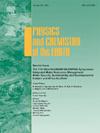评估波斯湾北部红树林气候和土地利用/土地覆盖变化对径流的影响
IF 4.1
3区 地球科学
Q2 GEOSCIENCES, MULTIDISCIPLINARY
引用次数: 0
摘要
红树林日益受到土地利用/土地覆盖(LULC)快速变化和气候变率的威胁。本研究利用马尔可夫链和多层感知器人工神经网络分析了1990年、2003年、2022年和2030年伊朗波斯湾北部Nayband红树林的时空动态。此外,利用威布尔方法分析了2003-2017年的最大24小时降雨量数据,估计了2、5、10、50和100年的回归期。为了评估气候变化的影响,使用LARS-WG模式对SSP126、SSP245和SSP585情景下ACCESS-ESM1-5、HadGEM3-GC31-LL和MRI-ESM2-0模式的日降雨量数据进行了缩减。土壤保持服务方法估算了不同气候变化和LULC条件下的径流高度和径流量。根据2030年LULC预测,相对于2022年,在SSP126的上述回归期内,径流量预计将下降4.88%、3.15%、2.44%、1.09%和0.96%。SSP245的降幅较小,分别为1.51%、1.02%、0.78%、0.15%和0.65%。SSP585情景预测径流量增加,分别增加16.28%、12.09%、21.32%、9.59%和9.21%。径流变率受气候变化的影响大于LULC变化的影响。因此,本研究的结果为制定管理战略提供了有价值的基础,重点是红树林的恢复和扩展,同时也支持在这个以石化、石油和天然气业务为主导的工业区域内进行明智的发展规划。本文章由计算机程序翻译,如有差异,请以英文原文为准。
Assessing the effects of climate and land use/land cover changes on runoff in the Mangrove Forests of the Northern Persian Gulf
Mangrove forests are increasingly threatened by rapid Land Use/Land Cover (LULC) changes and climate variability. This study analyzes spatio-temporal dynamics of the Nayband mangrove forests in the northern Persian Gulf, Iran, for 1990, 2003, 2022, and a projected 2030, using a Markov chain and Multi-Layer Perceptron Artificial Neural Network. Additionally, maximum 24-h rainfall data (2003–2017) were analyzed using the Weibull method to estimate return periods of 2, 5, 10, 50, and 100 years. To assess climate change impacts, daily rainfall data from ACCESS-ESM1-5, HadGEM3-GC31-LL, and MRI-ESM2-0 models under SSP126, SSP245, and SSP585 scenarios were downscaled using the LARS-WG model. The Soil Conservation Service method estimated runoff height and volume under various climate change and LULC conditions. Under 2030 LULC projections relative to 2022, runoff volumes are expected to decline by 4.88 %, 3.15 %, 2.44 %, 1.09 %, and 0.96 % across the aforementioned return periods under SSP126. SSP245 shows smaller reductions of 1.51 %, 1.02 %, 0.78 %, 0.15 %, and 0.65 %. In contrast, the SSP585 scenario projects an increase in runoff volume, with corresponding rises of 16.28 %, 12.09 %, 21.32 %, 9.59 %, and 9.21 %. The analysis revealed that runoff variability was more significantly affected by climate change than by LULC change. Accordingly, the findings of this study provide a valuable foundation for shaping management strategies focused on the restoration and expansion of mangrove forests, while also supporting informed development planning within this predominantly industrial region, defined by petrochemical, oil, and gas operations.
求助全文
通过发布文献求助,成功后即可免费获取论文全文。
去求助
来源期刊

Physics and Chemistry of the Earth
地学-地球科学综合
CiteScore
5.40
自引率
2.70%
发文量
176
审稿时长
31.6 weeks
期刊介绍:
Physics and Chemistry of the Earth is an international interdisciplinary journal for the rapid publication of collections of refereed communications in separate thematic issues, either stemming from scientific meetings, or, especially compiled for the occasion. There is no restriction on the length of articles published in the journal. Physics and Chemistry of the Earth incorporates the separate Parts A, B and C which existed until the end of 2001.
Please note: the Editors are unable to consider submissions that are not invited or linked to a thematic issue. Please do not submit unsolicited papers.
The journal covers the following subject areas:
-Solid Earth and Geodesy:
(geology, geochemistry, tectonophysics, seismology, volcanology, palaeomagnetism and rock magnetism, electromagnetism and potential fields, marine and environmental geosciences as well as geodesy).
-Hydrology, Oceans and Atmosphere:
(hydrology and water resources research, engineering and management, oceanography and oceanic chemistry, shelf, sea, lake and river sciences, meteorology and atmospheric sciences incl. chemistry as well as climatology and glaciology).
-Solar-Terrestrial and Planetary Science:
(solar, heliospheric and solar-planetary sciences, geology, geophysics and atmospheric sciences of planets, satellites and small bodies as well as cosmochemistry and exobiology).
 求助内容:
求助内容: 应助结果提醒方式:
应助结果提醒方式:


